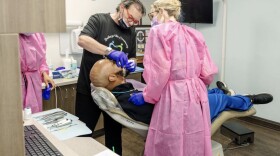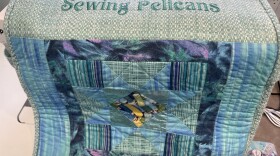Fort Myers City Council voted 5 to 2 on February 18 to start over procuring bids for repairs to the columns and fencing that surround Rachel at the Well.
Rachel, a 99-year-old statue of a Grecian maiden that stands at the entrance to Edison Park at Llewellyn Drive and McGregor Boulevard, is fine, but her "surround" has still not been rebuilt more than two and a half years after Hurricane Ian.
When it was installed in 1926, the statue was flanked by two tall columns that were connected by a curved wrought iron fence.

Over the years, the bougainvillea planted behind the sculpture became entwined in the fence’s vertical spires. During Hurricane Ian, that bougainvillea acted like the sail of ship, toppling the heavy wrought iron fence along with the top of the westernmost column. The fence landed on Rachel, breaking her back and neck.

The statue was restored in April 2024, but the columns, fence and retaining wall — collectively called “the surround” — has yet to be rebuilt.
This will be the third time the city advertises for a contractor to make the repairs to Rachel’s surround.
The first two times, Neubert Construction was the only contractor who responded to the city’s request for proposals. The first time, Neubert bid $450,000 to do the work. But when it filed its second bid six months later, Neubert’s price increased to $815,000.
At the City Council meeting, Tyler Neubert said that the work is far more involved than either he, city staff or its independent consultant, Tetra Tech, previously thought. He also cited the cost of maintaining a construction trailer on the job site and other general obligations, but he failed to adequately explain the $365,000 bump in price from his first to second bid.
City Manager Marty Lawing stated that an unnamed contractor has expressed doing the work at a more economical price, but several Councilpersons expressed skepticism that the city would get a different result by re-opening the bid process.
Ward 4 Councilman Liston Bochette echoed the concerns of fellow Edison Park homeowners and other community members that the repairs have not begun more than two-and-one-half years since Hurricane Ian, a situation that Public Works Director Peter Bieneck blamed on FEMA.
On a positive note, claims that new cracks have developed along Rachel’s back and at the base of the sculpture proved to be unfounded. Rachel at the Well is fine, even if her surround isn’t.

MORE INFORMATION:
Rachel at the Well’s official name is The Spirit of Fort Myers. City employees gave her the biblical nickname in the 1920s because of her proximity to the Thomas Edison Congregational Church.
The rumor of new cracks in the sculpture surfaced in a Facebook post on Sunday, February 16. Lee Trust’s Dr. Virginia Harper placed those concerns before City Council at the February 18 meeting. “I realize Rachel has been severely damaged, and now we find out she’s even more damaged than when the city repaired her,” said Harper. “I don’t know if Rachel can survive another major storm. One of our members called to tell me that she goes by her every day on her way home from work and it’s distressing to her that Rachel might fall down. I don’t think she’s going to fall down but, yes, she has cracks and damage.”

Architect Jeff Mudgett of Parker Mudgett Smith exacerbated these concerns when he urged Council to “get those conservators back” to address the community’s concerns “about Rachel deteriorating.”

As the accompanying photos illustrate, there are no new or pre-existing cracks in the sculpture and her conservators, Ciociola Conservation Art and Architecture and Rosa Lowinger & Associates, have certified that the statue is structurally sound.
Referring to Rachel as an “icon of our community," Fort Myers Historic Preservation Commission Chair Gina Sabiston voiced the community’s exasperation with the lack of progress on rebuilding Rachel’s surround. “It’s become complicated, it seems, and I don’t know why,” said Sabiston. “I get a lot of phone calls now about Rachel at the Well. ‘What’s happening with Rachel?’; ‘Why isn’t anything happening with Rachel?’”
In his explanation to City Council, Public Works Director Peter Bieniek pointed out that the city is seeking reimbursement from FEMA for the cost of repairing Rachel’s surround. To qualify, the city must submit an independent certified study. Staff hired a local engineering firm by the name of Tetra Tech do the study, which is, in essence, a cost estimate.
FEMA also requires at least two competitive bids. The first time the city advertised for contractors, it only received one bid, from Neubert Construction. for $450,000. It then put the project out for bid a second time. Again, the only bid it received was from Neubert Construction. But Neubert’s bid jumped from $450,000 to $815,000.
Because of the increase, Bieniek stated, “we came to Council and asked for the ability to negotiate” with Neubert for a lower price.
City Engineer Nicole Setzer met twice with Tyler Neubert to discuss the scope of work in anticipation of renegotiating his bid.
During those meetings, said Setzer, Neubert’s main concern was the structural integrity of the two arches that span the sidewalks to the east and west of Rachel and the surround. On the strength of a study conducted by his own engineers, Neubert had included in his bid the cost of tearing down and rebuilding both arches.

Architect Jeff Mudgett told Council that the engineers his firm hired to look at the arches had concluded that they were structurally sound. Accordingly, the architectural plans they drew up for repair of Rachel’s surround require the building contractor to make only cosmetic repairs to cracks in the plaster of the two arches before applying a fresh coat of paint.

The cost of tearing down and rebuilding the arches was not discussed during the City Council proceedings, and it does not appear that either Bieniek or Setzer offered to hold Neubert harmless for the arches' structural integrity if he would agree to remove the cost of tearing them down and rebuilding them from his bid.
In the absence of such a “hold harmless” clause or no-warranty agreement, Tyler Neubert insisted that best practices do not permit him or any other contractor to overlook defects such as cracks that might signify structural instabilities.

“When there’s no specifications, it’s the responsibility [of the contractor] to give the first, best workmanship," Tyler Neubert told Fort Myers City Council. "To me, repair means if there’s a structural crack in the wall, we can’t just put caulk in there and paint over it. You can go look at the other cracks that were done in 2017 and you can see the paint separating and the stucco delaminating.”
A second point of contention between city staff and Neubert Construction was the cost of complying with the general requirements section of the construction contract, such as the necessity for an on-site construction trailer and performance bond. Complying with those provisions accounted in Neubert’s second bid for more than $500,000 of the total cost of repairs.
“I put costs to everything and then I sent that at Mr. Bieniek’s request to him to say this is an area where we can shave some costs,” said Neubert. “Do I need an office trailer? You guys have never made me have one before. But the negotiations are a little bit contentious, so I have to itemize it on a list for you so that you know that the cost is covered.”
A final point that proved insurmountable was the efficacy of the Tetra Tech cost estimate. Neubert contended at Council that Tetra Tech failed to include in its budget estimate a number of expensive crucial steps required to secure the rebuilt columns on either side of Rachel to the bases that remained after the storm.
According to the architectural plans and comments made by Mudgett to Council, the base of the two columns that flank the sculpture were originally built out of hollow concrete blocks that were then covered with stucco and paint. In 2017, the base of each of each of these columns was fortified using a combination of solid concrete and steel, but only to a height of 5 feet.
The columns remained hollow above that height, and the uppermost column failed when the bougainvillea-entwined wrought iron fence was toppled by Hurricane Ian’s winds.

However, the wrought iron fence was only nominally attached to the tops of the columns. The main support for the wrought iron fence was its attachment to the concrete retaining wall behind the sculpture. However, the fence was secured to the retaining wall only by means of 2-inch bolts drilled into the open-cell concrete wall.

Those bolts proved insufficient to hold the fence in place in the face of Ian’s catastrophic winds.

Parker Mudgett Smith’s new plans call for the columns to be poured solid above the 5-foot bases and for longer bolts to be used to secure the fence to the retaining wall behind the sculpture. It will be necessary for the contractor to core drill into the existing bases so that rebar can be installed that stretches from 28 inches below grade to the very top of the rebuilt columns.

“This cost estimate does not represent the amount of work [contemplated by Parker Mudgett’s plans],” Neubert contended.
“Instead of trying to legitimize each individual line item, we went back with a counteroffer of $300,000 plus a $50,000 owner contingency for anything that may be found while we’re out there doing the job,” Bieniek told Council.
Bieniek reported that Neubert rejected the counteroffer out of hand.
That’s because, Neubert told Council, Staff had not correlatively reduced the scope of work or general requirements imposed by the contract documents. “I cannot assume risks and liability being compensated directly to do it, just like insurance."
Finding themselves at an impasse, Bieniek and Public Works decided to seek Council’s permission to terminate negotiations and solicit new bids.
An argument can be made that the Parker Mudgett plans over-engineer the remedy for the failures that occurred during Hurricane Ian. Had the bougainvillea not been permitted to entwine itself around and between the fence’s numerous upright spires, it is likely that Ian’s Category 4 winds would have passed without incident through the wrought iron fence.
Even after the reinforced columns are rebuilt, it will be advisable for city staff to keep the bougainvillea trimmed back and not permit it to become entwined around and between the uprights of the new fence.
Support for WGCU’s arts & culture reporting comes from the Estate of Myra Janco Daniels, the Charles M. and Joan R. Taylor Foundation, and Naomi Bloom in loving memory of her husband, Ron Wallace.







